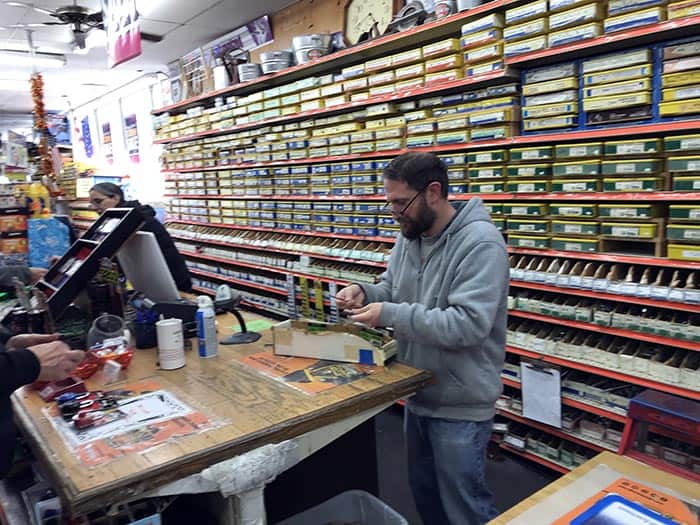
TOMS RIVER – A law increasing minimum wages went into effect July 1, and will top out at $15 an hour for most wage earners in 2024. Several local businesses said they’ll be able to shoulder the additional cost, but mostly because they don’t have too many employees.
Frank Kenny from Ken’s Hardware in Toms River has been a family-run business since his father opened up shop 42 years ago.
“We’ve always paid our employees more than minimum wage because we want to keep them here,” he said. “This $15 minimum wage is not going to affect me.”
At the time of the interview, the store had eight full time workers and four part time, not including Kenny and his brother. He said he wasn’t concerned about employees leaving for better paying jobs, because there are some that have been here a long time.
The owner of Perfect Swing Golf in Toms River, Mike Hovance, said he is only unaffected by it as he has a very small number of employees. A few years ago, when they were located in Lakewood, they had a driving range with nine employees. Many of them were pensioners with didn’t mind making $8-10 an hour. If he would have had to pay them almost twice as much, it would have crippled the business.
“We were at the highest end of what we could charge our customers anyway,” he said. “I couldn’t raise the prices anymore. People would stop coming.”
Further, it wouldn’t have helped his workers that much. There are a lot of retirees working in the golf industry. Those retirees just enjoyed coming out to the range, talking shop, and getting perks of working for a range.
“I understand people needing more money, but then you are charging more for goods and services,” he said.
The minimum wage increase is “long overdue,” said Ed Iannone, owner of Steve’s Comic Relief in Toms River. However, “it’s just going to put a lot of stress on mom and pop shops that employ part-time seasonal help. The first several years, I will be able to absorb without any issues. Going into the third, fourth and fifth years, I, like most other people running small operations, will more than likely will cut back on part time help.”
The hourly pay is only one piece of the puzzle, he said. There’s another side of it that the state is not talking about, and that’s the ancillary costs that this will bring. Worker’s comp is tied to payroll, so that will increase accordingly.
“I’ll also be paying toward Social Security because as an employer I’m picking up 50 percent of employee Social Security,” he said.
Five years down the road, he expects to see part time work vanish because small businesses can’t bring in enough profit to afford to pay them.
Alizar N. Zorojew, the executive director of the Downtown Toms River Business Improvement District, said he can see both sides of the issue. On one hand, people deserve a livable wage. On the other hand, it’s another challenge for small businesses.
“Private businesses could be more likely to automate or to ask more of employees,” he predicted.
He expects that – even without the legislation – the market would trend toward paying employees more to attract and retain better workers. If it had happened naturally it would have gone more smoothly.
Fortunately, the seasonal employees are on a different pay scale, said Lori Pepenella, Chief Executive Officer of the Southern Ocean County Chamber of Commerce. Many businesses in this region rely on seasonal help. The chamber had advocated for a gentler phase in for seasonal employees.
“It gives us more time before it actually hits,” she said. While the businesses understand the reasoning behind the increase, the chamber has been assisting them in preparing themselves for the increased costs.
“When you’re not having a full time staff, you’re retraining every year,” she said. So, the build-up in pay will keep trained employees coming back.

What Will The Increases Look Like?
The language of the bill is as follows: “The bill provides that, except for certain workers specified by the bill, the general minimum wage rate will be increased to $10 per hour on July 1, 2019, to $11 per hour on January 1, 2020, followed by $1 increases each year until the rate reaches a level of $15.00 per hour in 2024.”
Employers with less than six employees, or seasonal non-tipped employees, would have this instead: “The minimum wage rate will be increased to $10.30 per hour on January 1, 2020, and then increased each year from 2021 to 2025 by eighty cents, and then increased in 2026 by seventy cents so that it reaches a level of $15 per hour in 2026, followed by further increases from 2027 to 2028 as needed to have these employees provided the same minimum wage rate as the general minimum wage rate in 2028.”
Farm laborers would have yet another rate: “the rate will be increased to $10.30 on January 1, 2020, $10.90 on January 1, 2022, and increased by eighty cents in 2023, and eighty cents in 2024 so that the rate will be $12.50.” At this time, the commissioner and the Secretary of Agriculture would evaluate to see if more increases are warranted.
For workers who are tipped, employers will receive credit for tips against the hourly minimum wage rate the employer pays, as follows: “from January 1, 2019 to June 30, 2019, $6.72; after June 30, 2019 and before January 1, 2020, $7.37; during 2020, 2021 and 2022, $7.87; during 2023, $8.87; and during 2024 and subsequent years, $9.87.”






